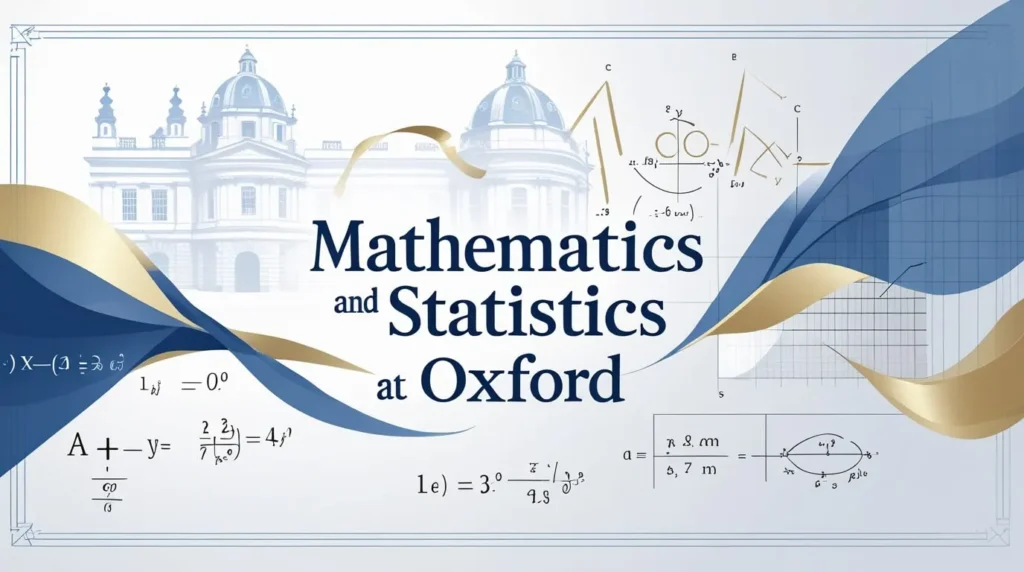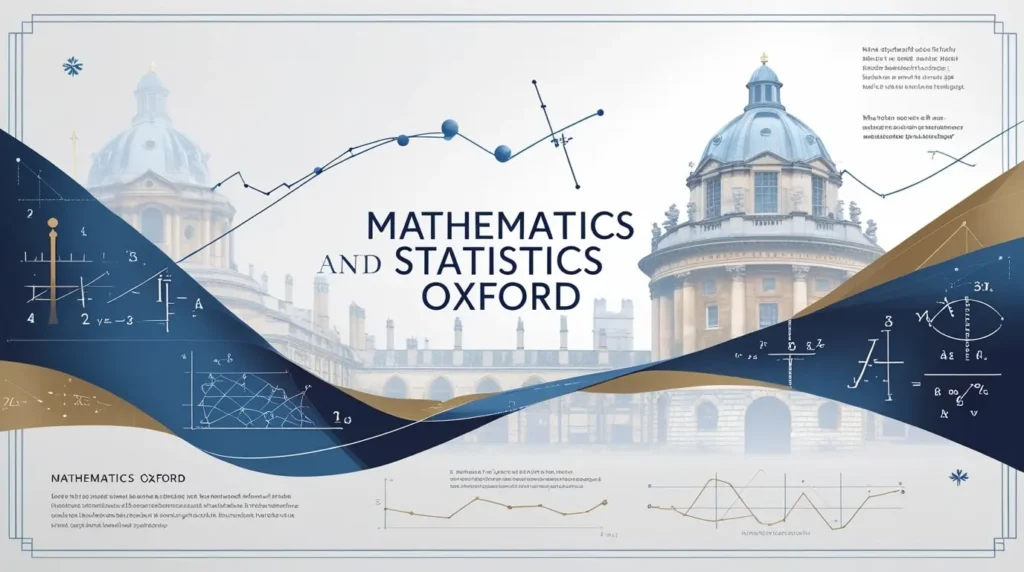Mathematics and Statistics
Mathematics and Statistics is a highly esteemed course offered at Oxford University, blending rigorous mathematical theory with practical statistical applications. This program prepares students to address the challenges presented by the increasingly data-driven world. With societal reliance on data growing exponentially, professionals proficient in extracting meaningful insights from complex datasets are in high demand. Oxford’s Mathematics and Statistics degree, with UCAS code G100, offers both a three-year BA and four-year MMath option, designed to cultivate deep theoretical knowledge alongside hands-on experience in statistics and computation.
Why Study Mathematics and Statistics?
Mathematics and Statistics stand at the core of countless scientific advances and modern technologies. Studying these disciplines at Oxford equips students with exceptional analytical and problem-solving skills. The curriculum amalgamates pure mathematics and applied statistics to ensure graduates can design and apply statistical methods across diverse fields—ranging from finance and medicine to genetics and artificial intelligence.
The field’s significance is underpinned by the proliferation of “Big Data” in business, healthcare, social sciences, and natural sciences. As Oxford’s Department of Statistics pioneers research in cutting-edge statistical machine learning, students gain exposure to revolutionary techniques for analyzing massive datasets and uncovering hidden patterns.

Admission Requirements
Oxford’s Mathematics and Statistics course demands academic excellence. Applicants typically present AAA at A-level with A* grades mandatory in Mathematics and Further Mathematics if available. In cases where Further Mathematics is not offered, alternative qualifications such as AS-level Further Mathematics alongside other strong A-levels are considered. For international students, equivalent qualifications such as the International Baccalaureate with a score of 39 and a 7 in Higher Level Mathematics fulfill the requirements.
A key part of the admissions process is the Mathematics Admissions Test (MAT), designed to assess problem-solving abilities beyond the conventional curriculum. Candidates must register early for the MAT, which takes place in October. Oxford values students who exhibit imaginative and deep thinking about mathematical patterns, intellectual curiosity, and the motivation to go beyond prescribed syllabi.
Course Structure
The first year mirrors the Mathematics course and lays a firm foundation in core mathematical disciplines. Students cover Algebra, Analysis, Probability and Statistics, Geometry, Dynamics, and Multivariable Calculus. Assessments include written examinations and computational mathematics projects that emphasize practical application.
In the second year, the course introduces more specialized Probability and Statistics topics, alongside core mathematical subjects like Differential Equations, Metric Spaces, and Complex Analysis. Students begin to choose from a wider menu of options, including Simulation and Statistical Programming.
The third year broadens choices further, with options such as Applied and Computational Statistics, Statistical Inference, Statistical Machine Learning, and Applied Probability. These courses integrate modern computational methods and data analysis techniques, preparing students for work in data-intensive environments. Students undertake Part B examinations, which evaluate practical and theoretical understanding.
The four-year MMath option provides the opportunity for a deeper dive in the final year, including a substantial Statistics dissertation. Advanced courses such as Stochastic Models in Mathematical Genetics, Probability and Statistics for Network Analysis, and Algorithmic Foundations of Learning reflect the latest research trends and applications.
Teaching and Learning
Oxford’s teaching combines traditional lectures and practical tutorials. A typical week in the initial years involves around ten lectures supplemented by small-group tutorials that foster personalized learning. Later years see a mix of lectures, tutorials, and lab sessions where students work closely with statistical software and computational tools.
Tutorials typically consist of 2-4 students, enabling instructors to tailor guidance to individual learning needs. Oxford students consistently praise the direct interaction with world-leading experts and the supportive academic community created by such intimate teaching formats. Doctoral students also contribute to teaching, providing fresh perspectives and additional mentorship.
Student Life and College Community
Oxford’s distinctive college system is integral to the student experience. Each student belongs to a college, offering a smaller community within the larger university framework. Colleges provide accommodation, libraries (often open around the clock), dining halls, common rooms, and pastoral support.
First-year students receive guaranteed college accommodation, easing the transition into university life surrounded by peers experiencing the same new environment. Beyond academic support from tutors, colleges offer welfare officers, peer mentors, and a wealth of extracurricular activities. This inclusive community fosters both academic success and personal growth throughout the degree.

Career Opportunities
Graduates from the Mathematics and Statistics program enjoy excellent job opportunities, with over 95% of recent alumni engaged in employment or further study within six months of graduation. Their analytical skills equip them for careers in finance, insurance, consulting, health data analysis, technology firms, and government research.
The explosive growth of data science has fueled demand for statisticians and mathematicians capable of building and interpreting predictive models. Oxford graduates frequently enter fields such as actuarial science, machine learning, quantitative finance, and biostatistics, where their training in both theory and applied statistics is highly valued.
Financial Support and Tuition Fees
Currently, full-time Home undergraduate students face tuition fees capped at £9,535 for the 2025/26 academic year, while international students pay an annual fee of approximately £47,570. Oxford provides some of the most generous financial support packages available in the UK, including bursaries and scholarships aimed at low-income families to ensure access does not depend on financial means.
Living costs at Oxford may be surprisingly manageable due to college facilities such as libraries and accommodation. Estimated living expenses range from £1,405 to £2,105 per month, accounting for term dates and breaks. The university’s financial aid extends to loans, scholarships, and contextual support, fostering an inclusive environment for students from diverse backgrounds.
How to Excel in Mathematics and Statistics at Oxford
Success in this demanding course requires consistent effort, active participation in tutorials, and a proactive attitude towards problem-solving. Students benefit from forming study groups, engaging with faculty research seminars, and using university resources, including computing labs and statistical software training.
Developing a strong foundation in both theoretical mathematics and programming skills enables students to tackle complex statistical challenges. Additionally, balancing academic responsibilities with the rich cultural and social opportunities within Oxford’s colleges helps maintain a healthy, well-rounded student life.
Conclusion
Oxford University’s Mathematics and Statistics degree combines a robust grounding in mathematics with the practical application of statistical methods to real-world problems. The course’s academic rigor, expert faculty, and vibrant collegiate community prepare graduates for successful careers in a rapidly evolving data-centric world. With generous financial aid and a supportive environment, Oxford opens doors for talented students to excel in this essential and exciting field.
